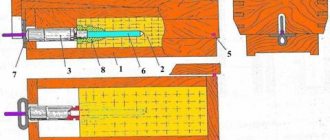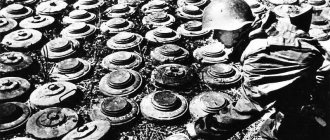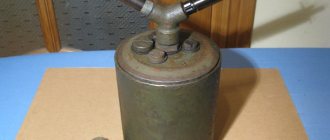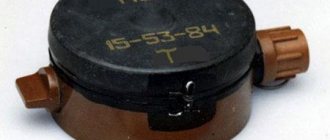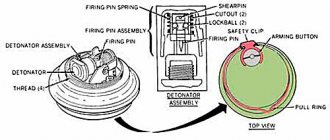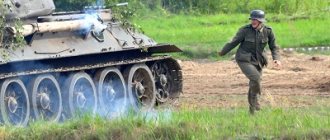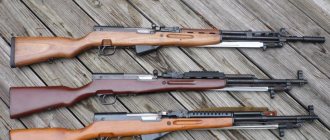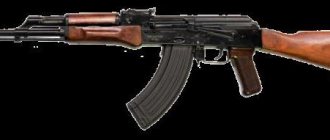To counter the maneuver and advance of enemy forces on land, minefields are widely used - artificial obstacles erected in advance or immediately before combat operations in order to inflict maximum damage to enemy personnel and destroy his equipment and weapons.
Among all engineering ammunition, the most effective is the MON-50 directed-action anti-personnel mine. This type of explosive shell was first used during combat operations in Afghanistan. Since then, the mine has been significantly improved and has been developed in the form of several modifications.
Anti-personnel mine
MON-50 is the first domestic fragmentation mine designed to destroy enemy personnel. It is a rectangular prism made of plastic. It can be used to destroy soldiers in armored vehicles and other lightly armored vehicles.
The enemy is defeated with metal balls (6.35 mm in diameter) or rollers (rollers). The MON-50 anti-personnel mine with metal rollers causes greater damage to the target due to the special shape of the striking elements.
Depending on the type of fuse installed, the mine can be activated from a remote control at the operator's command or when an enemy soldier touches a break/tension sensor. The engineering projectile is installed on the ground on special folding legs or attached to horizontal surfaces and local objects using a clamp.
Predecessors
During the Great Patriotic War, the USSR was armed with the PMD-6 anti-personnel mine. It was a 200-gram TNT block in a wooden (other materials were also used, including slate) case. The PMD-6 was triggered by pressure, that is, you had to step on it.
In the post-war years, the mine was removed from service, and it was replaced by the PMN. The mass of the charge remained the same, but the body became plastic, and more advanced pressing and trigger mechanisms appeared. The PMN in various modifications was produced for a long time - the latest version was put into service in 1990.
Fragmentation mines were represented by such a sample as POMZ-2.
Its thick cast iron body contained 75 g of TNT. POMZ-2 was stuck into the ground using a wooden peg, and was triggered when the pin was pulled out by a torn tripwire. The radius of destruction of this mine was relatively small - only 4 m, but it was intended to be used as part of barriers. Thus, directional mines did not completely replace, but supplemented existing models.
Design of MON-50
Externally, the mine is a narrow convex rectangular prism. Its design includes five main elements: a body, striking elements, a fuse, an explosive charge and a clamp.
The body is made of plastic. This makes it possible to reduce the total mass of the projectile and at the same time makes it difficult for mine detectors to detect it. In the upper part of the body there are two threaded holes for installing fuses for the EDP-r electric detonator or for loading the MD-5M fuse, as well as an aiming slot and an arrow indicating the direction of action. On its lower wall, the MON-50 mine has folding legs for installing the device in snow or ground, as well as a flange for attaching a clamp.
The damaging elements are metal balls (6.35 mm in diameter) or cylinders (rollers) with a height of 7 mm and a weight of 1.5 grams. The fragments are located in one layer on the inside of the convex part of the body and filled with epoxy resin. The identical dimensions and geometry of the striking elements allow them to spread evenly in space and maintain their initial speed longer due to their good aerodynamic shape.
Electromechanical fuse MVE-08
The electromechanical fuse MVE-08 is intended for loading anti-personnel fragmentation mines OZM-72, MON-50, MON-90, MON-100, MON-200, POMZ-2 (2M), signal mine SM, anti-personnel fragmentation ammunition POB, as well as any ammunition and charges that have a socket for an MD-5M fuse or an initiation device, installed manually for the construction of anti-personnel mine-explosive barriers in order to destroy enemy personnel.
Performance characteristics:
| Fuse type | electromechanical with self-destruction and self-deactivation mechanisms |
| Overall dimensions of MVE-08 fuse, mm max | |
| 62,5 | |
| 86,4 | |
| Fuse weight, kg max | 0,31 |
| Current source | ampoule |
| Activating the current source | manually, with a special key |
| Trigger type | lever, manual |
| Type of long-range cocking mechanism | two-channel (electronic and deformation) |
| Long-range cocking time, min: | |
| 6 +-10% | |
| 0,3 — 6,6 | |
| Safe performance monitoring during use | indicator light with operating time 4.7 minutes +- 10% |
| Self-liquidation time in the temperature range of use, days. | 27 +- 10% |
| Self-deactivation time, days. | 30 — 120 |
| "Indestructible" mode | constant |
| Non-removable mode | switchable |
| Number of break target sensors, pcs | 1 |
| Length of wire of break sensor, m | 160 +- 5 |
| Target sensor wire break force, N | (4 — 5) |
| Application operating temperature range, °C | -40 to +50 |
| Guaranteed shelf life, years | 10 |
Explosive charge and detonating device
Hexogen is used as an explosive charge. Its weight is 0.7 kg, its location is behind the killing elements (it fills the entire cavity free from fragments). To detonate the charge, the MON-50 mine is equipped with an EDP-r electric detonator or an MD-5M fuse with a piercing mechanism.
Both devices are used to remotely detonate explosives. EDP-r looks like a detonator capsule, in the barrel of which an electric igniter with a filament bridge made of nichrome or platinum-iridium alloy is placed. The electric detonator has established itself as one of the most reliable.
The unguided version of the mine is equipped with an MVE-72 or MUV fuse, which was used during the Second World War. In this case, the mine is activated when the fuse sensor (MVE-72) is touched or the detonator wire of the MUV series is displaced.
Story
The use of explosive mechanisms filled with destructive elements in many wars has proven one hundred percent effectiveness of their use in eliminating fortified structures, enemy infantry and military equipment. Discoveries in the field of chemistry: the appearance of xyloidin, pyroxylin, liquid nitroglycerin, TNT and saltpeter - as well as mankind’s already rich experience in warfare - served as a good impetus for the improvement of explosive devices.
Primitive plantings under enemy walls using safety cords are a thing of the past. Their place was taken by modern products using special capsules - detonators and electric ignition systems.
Due to their secrecy, explosive mechanisms buried in the ground have always been considered very dangerous. But time has shown that their effectiveness is not one hundred percent, since the mine directly eliminated only the object that came into contact with it, and left others undamaged. A much better result could have been achieved if the mine had been above the ground. But in that case it would be visible. This shortcoming in the mine field required an immediate solution, which was the device called OZM-72. Let's take a closer look at it.
Performance characteristics
The ancestor of the MON-50 mine was the M18 Claymore engineering ammunition of the US troops, which was actively used during the fighting in Vietnam.
The performance characteristics of the MON-50 mines differ from the characteristics of the American analogue in a more focused radius of dispersion of fragments, as well as a number of other indicators:
- total mass of the mine – 2 kg;
- dimensions (WxHxD) – 226 x 90 x 66 mm;
- number of killing elements - 485 balls or 540 rollers;
- damage sector – 54o;
- fragment scattering radius – 50 m, height – 4 m;
- the range of destruction of vehicles and manpower in them is up to 30 m.
The mine can remain cocked for an unlimited amount of time. There are no mechanisms for self-destruction, non-removal and non-neutralization. Safe distance from the mine in the rear is 30 meters. But in practice, judging by reviews, fragments do not affect personnel at a distance of 12-15 meters.
Exploitation
Although the MON-100 anti-personnel mine entered service in the early 60s, its use was limited. In fact, they tried to use it only in the 80s during the Afghan war. Ammunition supplies for export were also small. The reason is simple - the mine was unsuccessful and ineffective.
Yes, the destructive elements have significant destructive power and fly over a long range (for a mine). But in order to disable manpower or equipment, fragments must hit it. And given that the width of the beam of fragments in the maximum damage zone is only 5 m, the entire lethal flow could easily “fly in” for other purposes. This made it all the more difficult to incapacitate the group target.
This limited the scope of application of the MON-100, making controlled detonation from a remote control the only method of use. This method also turned out to be far from ideal. The safe range from the back of the mine was estimated in the regulations as 35 m, but practice has shown that individual fragments (especially the remains of the bracket) can fly further. So taking a position from which it was possible to accurately calculate the moment of detonation was not an easy task.
It was a MON-50, basically copied from the American Claymore mine. It had half the weight and was more convenient to carry (having the shape of a compact rectangle). Its destructive elements had a shorter range of destruction, but the width of their spread reached 50 m, which made it easy to “cover” and disable an entire squad. At the same time, the MON-50 was also equipped with a sight-window in the body, through which the sapper operator observed the affected area.
The disadvantages of the MON-100, however, were not associated with the features of its design. This can be concluded from the fact that the MON-200 was adopted for service. The design was similar to the “hundredth”, but with one difference – the dimensions and weight were larger.
The weight of the ammunition reached 25 kg, and the charge - 12 kg (which is comparable to a large-caliber howitzer shell). As a result, the width of the affected area increased slightly (remaining within 10-15 m), but the ammunition itself became simply too heavy to lift. The danger zone for the operator has also increased.
Planting a mine in the ground
The MON-50 (mine) can be installed in several ways. Mining methods depend on terrain and climatic conditions.
To fix the device in the ground in advance, you must:
- Loosen the igniter hole plug.
- Spread the legs and turn the projectile with the convex side towards the enemy.
- Using the aiming device, aim the device at the target.
- Press the legs of the mine into the ground to a depth that ensures a stable position.
- Screw one of the detonators into the ignition socket.
- Disguise the mine.
When using EDP-r, connect the cable to the electrical control network. If the situation allows, then for aiming a vertical pole 60 (160) centimeters high is installed at a distance of 10 (30) meters.
Genres
- Combat fantasy
- Heroic fantasy
- Urban fantasy
- Gothic novel
- Detective fiction
- Ironic fiction
- Ironic fantasy
- Historical fantasy
- Cyberpunk
- Space fiction
- Space opera
- LitRPG
- Mystic
- Science fiction
- Non-science fiction
- Misfits
- Post-apocalypse
- Fairytale fantasy
- Social and philosophical fiction
- Steampunk
- Technofantasy
- Horror and mysticism
- Fiction: other
- Fantasy
- Epic fantasy
- Humorous fiction
- Humorous fantasy
- alternative history
- Action
- Ladies' detective novel
- Ironic detectives
- Historical detectives
- Classic detectives
- Crime detectives
- Cool detective
- Maniacs
- Medical thriller
- Political detectives
- Police detectives
- Other Detectives
- Thrillers
- Spy detectives
- Aphorisms
- Military prose
- Historical prose
- Classic prose
- Counterculture
- Magic realism
- Novella
- Tale
- Prose other
- Story
- Novel
- Russian classical prose
- Family Romance/Family Saga
- Sentimental prose
- Soviet classical prose
- Modern prose
- Epistolary prose
- Essay, sketch, sketch, sketch
- Extravaganza
- Historical romance novels
- Short romance novels
- Romance and fantasy novels
- Suspenseful romance novels
- Porn
- Other romance novels
- Slash
- Modern romance novels
- Erotica
- Femslash
- Westerns
- Historical Adventures
- Sea adventures
- Adventures about Indians
- Nature and animals
- Other adventures
- Travel and Geography
- Children's educational literature
- Children's prose
- Children's fiction
- Children's action-packed
- Children's adventures
- Children's poems
- Children's folklore
- Game book
- Other children's literature
- Fairy tales
- Fables
- Free verse
- Visual poetry
- In verse
- Dramaturgy
- Lyrics
- Palindromes
- Song poetry
- Poetry
- Experimental poetry
- Epic poetry
- Ancient literature
- Ancient Eastern literature
- Old Russian literature
- European ancient literature
- Myths. Legends. Epic
- Other ancient literature
- Alternative medicine
- Astronomy and space
- Biology
- Biophysics
- Biochemistry
- Botany
- Veterinary
- Military history
- Geology and geography
- State and law
- Child psychology
- Zoology
- Foreign languages
- Story
- Cultural studies
- Literary criticism
- Mathematics
- Medicine
- Social science
- Organic chemistry
- Pedagogy
- Policy
- Other scientific literature
- Psychology
- Psychotherapy and counseling
- Religious Studies
- Abstracts
- Sex and family psychology
- Technical science
- Textbooks
- Physics
- Physical chemistry
- Philosophy
- Chemistry
- Cheat sheets
- Ecology
- Jurisprudence
- Linguistics
- Analytical chemistry
- Database
- Internet
- Computer hardware
- OS and networks
- Programming
- Software
- Other computer literature
- Other reference books
- Guides
- Guides
- Dictionaries
- Directories
- Encyclopedias
- Biographies and memoirs
- War documentary
- Art and Design
- Criticism
- Sciencepop
- Other non-fiction
- Journalism
- Astrology
- Hinduism
- Orthodoxy
- Protestantism
- Other religious literature
- Religion
- Self improvement
- Christianity
- Esoterics
- Paganism
- Palmistry
- Jokes
- Comedy
- Other humor
- Satire
- Humorous prose
- Humorous poems
- Pets
- Health and beauty
- Cooking
- Other home economics
- Entertainment
- Garden
- Do it yourself
- Sport
- Hobbies and crafts
- Erotica and sex
- Banking
- Foreign economic activity
- Business literature
- Office work
- Corporate culture
- Personal finance
- Small business
- Marketing, PR, advertising
- Popular about business
- Job search, career
- Trade
- Management, recruitment
- Securities, investments
- Economy
Miscellaneous
Cars and traffic rules
- Newspapers and magazines
- Fine arts, photography
- Movie
- Music
- Teen literature
- Theater
- Fanfic
- Vaudeville
- Drama
- Film scripts
- Mystery
- Scenarios
- Tragedy
- Epics
- Puzzles
- Folk tales
- Proverbs, sayings
- Folklore: other
- Intelligence services
- Martial arts
- Military equipment and weapons
- Military affairs: other
Installing a mine on snow, on local objects
Installation of the MON-50 mine with a snow drift height of less than 20 cm is carried out on a bag pre-filled with snow, which is placed on a well-compacted snowdrift. After installing the engineering ammunition, it is sprinkled to the lower edge of the hull, and is also camouflaged with loose snow. It is important that the thickness of the snowdrift in front of the convex wall is no more than 10 cm.
If terrain conditions do not allow fixing a mine in the ground or snow, then it is installed on local objects. To do this, a clamp is screwed into the flange on the lower edge of the housing. It is attached to wooden posts and trees using a screw, and to metal structures using a fixing screw and nut. In this case, the order in which the mine is brought in does not change.
Bookmark stages
How is OZM-72 laid? The explosive mechanism is installed manually into the ground or snow.
The bookmarking process consists of the following steps:
- arrangement of a hole with a diameter of up to 200 mm with further placement of a mine in it;
- installation of a detonating capsule;
- installing a metal peg at a distance of 50 cm from the mine;
- fastening the cable with carabiners to the guy wire;
- installing one wooden peg with a wire passed through it for the entire length; the end of the guy rope must be attached to the top of the second peg; It is imperative that the wire between the wooden stakes sag a little - 20-30 mm is enough;
- unscrewing the protective cap covering the mine igniter;
- bringing the fuse pins into combat condition;
- connecting the prepared trip wire to the fuse pin using a carabiner;
- camouflage of an installed mine.
Methods of neutralization
The technology for neutralizing a mine depends on the type of detonator installed. If a controlled fuse of the EDP-r type is used, then it is necessary:
- Disconnect the electric detonator from the control network.
- Unmask the mine and remove the fuse.
- Remove the device from the installation site.
If the MON-50 mine is equipped with an MVE-72 fuse, then its neutralization is impossible. In this case, it is destroyed by trawling in accordance with the instructions. When using less common fuses VZD-6ch or VZD-144ch (delayed action fuses), mine clearance is carried out exclusively by trained sappers in accordance with the instructions for this type of detonator.
Principle of operation
Milking occurs when a vacuum is applied to the milking machines. The milk is “sucked” into the milk line and moved to the milk compartment. Along the way from the animal to the collection site, the milk is freed from air and mechanical impurities.
The extraction of air bubbles occurs in a large glass container, from where the milk is pumped out through the bottom with a milk pump. Coarse suspensions are removed when passing through the filter device.
The vacuum and milk pipelines are supplied by movable milking units. After serving one cow, they go upstairs, automatically clearing the occupied feeding passage.
Switching the milking and washing modes starts the automatic cleaning of the system. The required degree of processing is ensured by software control of the process and the possibility of recirculating the solution in the system.
Four operators (milkers) are allowed to work at the same time. Each of them serves three or four individual milking units. All operations are carried out only when the animals are tied in stalls.
Combat use
MON-50 mines were actively used to protect borders, airfields, and checkpoints of Soviet troops during the Afghan War. At the same time, the method of installing minefield nodes in gorges, where, according to intelligence data, caravans or units of rebels were supposed to pass, became particularly widespread.
During combat operations, the MON-50 mine gained wide fame among Soviet soldiers, especially among those who had to serve for many hours on patrol or at checkpoints. The result of “national fame” was the appearance of the MON-90 modification, which was supposed to be favorably distinguished by its greater flight range of fragments (up to 90 m).
But in practice, the lethal elements of the MON-90 mine barely reached the 50-meter line. Due to the same efficiency, but much greater weight and dimensions, this modification did not gain fame among the soldiers. Currently, there are several modifications of this ammunition with a range of 100 and 200 meters.
DescriptionEdit
Immediately after the Battle of Endor, the Mon Calamari (Dac) shipyards, which were the best HP shipyards of those years, were tasked with developing a new ship that would fully meet the new military-political realities. But fulfilling the order turned out to be not so easy. The development of a new battlecruiser and the construction of the lead ship of the series, named Defiance, dragged on for five years. The "Challenge" was removed from the stocks and armed only at the beginning of the campaign of the Reborn Emperor (10 ABY).
Unlike the MC80, the MC90 battlecruiser is a full-fledged combat ship, one of the few worthy opponents of the Star Destroyer. The total power of its side salvo exceeded the power of IZR cannons. An effective armor system and the power of two deflector generators allowed the MC90 to withstand fire from even heavy ISM turbolasers for a long time. A very useful feature of the deflectors was the ability to quickly restore the integrity of the protective field. This made it incredibly difficult to completely remove the MC90's shields. And lastly, the MC90 turned out to be faster and more maneuverable than many ships of a similar class, both in the fleet of the New Republic and in the fleet of the Empire.
The management system has undergone significant changes. Now the MC90 could be controlled not only by natives of Mon Calamari, but also by representatives of other races. This was an important and necessary step towards the development of the New Republic fleet, because the number of HP ships was rapidly increasing every year and there simply were not enough qualified natives of Dac to form the crews of all the battlecruisers.
Another important advantage of the MC90 was a different construction philosophy. The name of this philosophy is standardization. Let me remind you that MC80 of all modifications were built “as the fish god puts his heart on.” Because of this, each “eighty” differed from a sistership not only in the internal layout, but even in the contours of the hull. The modular structure of the MC90 and the standardization of the ship's exterior and interior significantly simplified its mass production and operating costs. Thanks to the same design, the MC90 could be assembled even at non-Mon Calamarian-type shipyards. The MC90 was the first major New Republic warship to be built outside of the Mon Calamari shipyards. The first shipyard at which the MC90s of the second series were laid were the stocks in Sluis Van orbit.
Since the MC90, unlike the IZR, was primarily focused on conducting space combat with enemy ships, the number of troops transported was significantly reduced. However, even the existing infantry regiment with equipment was enough to capture and hold a planetary base, small colony or space station.
The MC90 received special attention in the New Republic fleet. They usually became the flagships of the most combat-ready squadrons, sometimes being the basis of their firepower
However, due to their great value to HP, most of the released MC90 were kept closer to the Core worlds, rarely sent to fight the Remnant fleets. The situation seemed tragicomic. The newest battleship, the only one in the New Republic fleet capable of single-handedly coping with a Star Destroyer, was kept in the orbits of the most guarded worlds as a scarecrow. At the same time, the old MC80s of all modifications, which had undergone several major overhauls, continued to fight and die under the guns of imperial battleships.
2.2. Actions of the squad upon detection of a radio-controlled landmine
- When a sapper (usually equipped with an OSI proximity mine detector) detects a radio-controlled landmine, the command is given: “Move back and take up a perimeter defense.”
- Only one sapper approaches the detected landmine, and with the help of a “Cat” he trawles the area adjacent to the landmine. The actions of a sapper who discovers a radio-controlled land mine are covered by a sapper equipped with an RP-377 jammer.
- The combat guard carries out harassing shelling of the area at possible enemy locations.
- A detected landmine is destroyed on the spot by one sapper overhead charge. It is strictly forbidden to remove (remove) a detected landmine.

